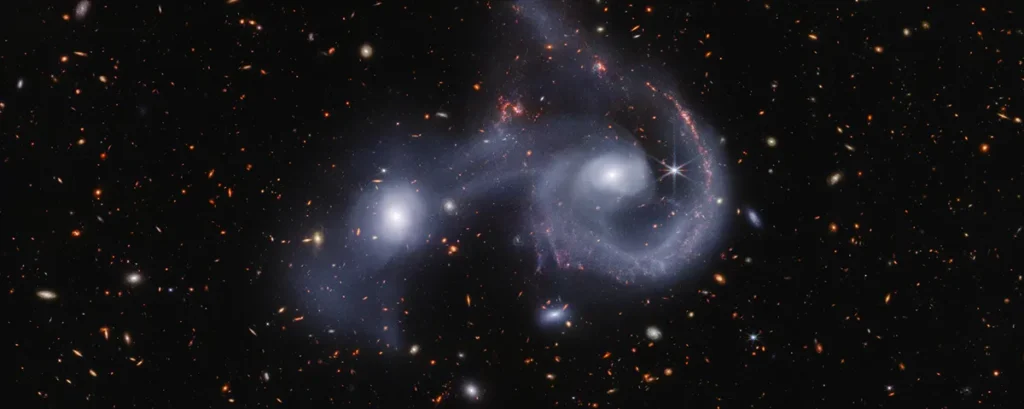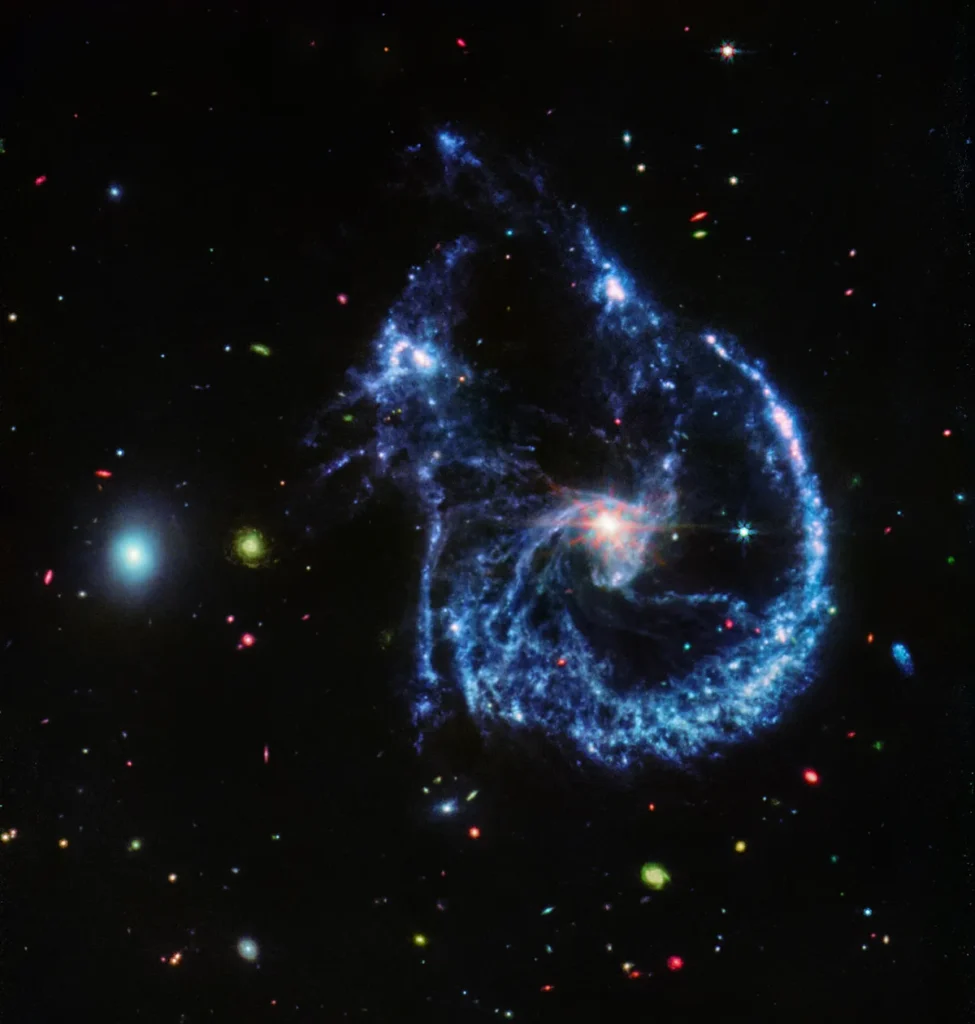The James Webb Space Telescope (JWST) has once again amazed us with a breathtaking view of the universe, this time capturing the collision of two galaxies that resemble a giant cosmic smiley face. Known as Arp 107, this galactic merger, 465 million light-years away in the constellation Leo Minor, showcases the incredible dynamics of space where galaxies collide, interact, and create new stellar formations.
The Galactic Collision: Arp 107 Explained
Arp 107 is a striking example of a galactic collision in progress. In this cosmic dance, a massive spiral galaxy is merging with an elliptical galaxy, creating a bridge of stars and gas that seems to smile back at us from the depths of space. Webb’s powerful instruments, including the Mid-Infrared Instrument (MIRI) and the Near-Infrared Camera (NIRCam), reveal an unparalleled view of this process, capturing the intricate details of star formation, gas dynamics, and the immense gravitational forces at play.
This collision is not a random smash-up; rather, it’s a highly organized, albeit slow, process that takes millions of years to unfold. The gravitational pull between these galaxies causes tidal forces that stretch and warp them, creating structures like the faint, white bridge seen in Webb’s image. This bridge is filled with stars and interstellar gas, evidence of the intense gravitational interactions that pull material from both galaxies.
Why This Image Is Groundbreaking
What makes the Webb image of Arp 107 so groundbreaking is the level of detail it provides. Unlike previous observations, Webb’s advanced infrared capabilities allow us to peer through cosmic dust that typically obscures these events. The NIRCam data highlights the stars within both galaxies, while MIRI shows areas of active star formation, illuminated by the hot glow of a supermassive black hole at the center of the spiral galaxy.

The spiral galaxy in this image is classified as a Seyfert galaxy, a type known for its bright core powered by a supermassive black hole. This core glows fiercely in the infrared spectrum, providing clues about the galaxy’s energy dynamics and the role of black holes in galactic evolution. The image showcases how collisions can ignite bursts of star formation, as gas clouds compress under gravitational stress.
Galactic collisions are more than just a spectacular cosmic show—they are key events that shape the universe. When galaxies collide, their vast amounts of gas and dust are thrown into disarray, compressing in some regions to form new stars while dispersing in others. This process can either trigger intense starburst activity or, paradoxically, scatter the ingredients necessary for star formation across the universe.
The sheer scale of these mergers is mind-boggling. Individual stars, despite their numbers, rarely collide due to the vast distances between them. Instead, the interactions happen on a grander scale, with gravity guiding the movement of gas, dust, and stellar bodies. Webb’s image of Arp 107 gives scientists a front-row seat to these galactic forces at work, providing insights into how similar mergers in the early universe may have influenced the formation of the galaxies we see today.
The Long-Term Implications of the Collision
Arp 107’s smiley face may seem whimsical, but the long-term outcome of this merger is anything but simple. Over the course of hundreds of millions of years, the spiral and elliptical galaxies will gradually blend into a single, larger galaxy. This process of galactic evolution is fundamental to the life cycle of the universe, demonstrating how galaxies grow and change over time.

The bright, active core of the Seyfert galaxy suggests that black holes play a significant role in these mergers. As gas and dust are funneled into the galactic center, they feed the supermassive black hole, which in turn emits powerful jets and radiation that can influence star formation across the entire galaxy. Understanding these interactions helps astronomers piece together the puzzle of how galaxies evolve, merge, and sometimes cease to form new stars altogether.
How Webb’s Observations Are Changing Our View of the Universe
The James Webb Space Telescope represents a leap forward in our ability to observe the cosmos. Its infrared instruments are capable of seeing through cosmic dust and capturing images of celestial objects with unprecedented clarity. This capability is not just about pretty pictures; it’s about uncovering the secrets of the universe’s most dynamic processes.
In the case of Arp 107, Webb’s data provide a detailed look at the forces shaping the merger. The image allows scientists to study the precise regions where star formation is occurring, the influence of the supermassive black hole, and the way gas and dust are distributed throughout the merging galaxies. Each of these elements tells a part of the story of galactic evolution, helping us understand how our own Milky Way might look in the distant future when it inevitably collides with its neighbor, the Andromeda galaxy.
What We Can Learn from Arp 107
Arp 107 serves as a vivid example of the complex and often chaotic nature of the universe. By studying these collisions, astronomers can learn how galaxies like our own have been shaped by past mergers. It also offers a glimpse into the potential future of our galaxy, as the Milky Way is on a slow-motion collision course with Andromeda.
The study of galactic mergers also helps scientists refine models of star formation, galactic dynamics, and the role of supermassive black holes in regulating these processes. The observations made by Webb will feed into simulations and theoretical models that attempt to recreate the conditions seen in Arp 107, providing a testing ground for our understanding of cosmic evolution.
Conclusion: The Ever-Unfolding Story of the Universe
The James Webb Space Telescope’s capture of Arp 107 is more than just a stunning visual—it’s a window into the universe’s most fundamental processes. From star formation to the role of black holes, this galactic collision offers a wealth of information that deepens our understanding of the cosmos. As Webb continues to explore, it will undoubtedly reveal more of these spectacular events, helping us unravel the complex tapestry of space and time.
In the end, Arp 107 is a reminder of the dynamic, ever-changing nature of the universe. Galaxies collide, merge, and transform, driven by the invisible forces of gravity and shaped by the vast interplay of gas, dust, and dark matter. Thanks to Webb, we can witness these events unfold with unprecedented detail, bringing us closer to understanding the grand narrative of the cosmos.
Reference:



















